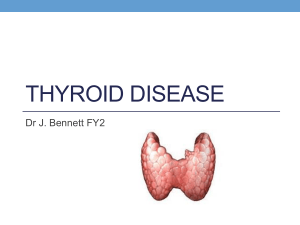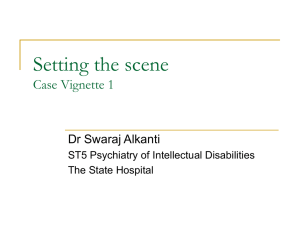Thyroid Disease Pierre-Marc Bouloux Royal Free Campus UCL 1
advertisement
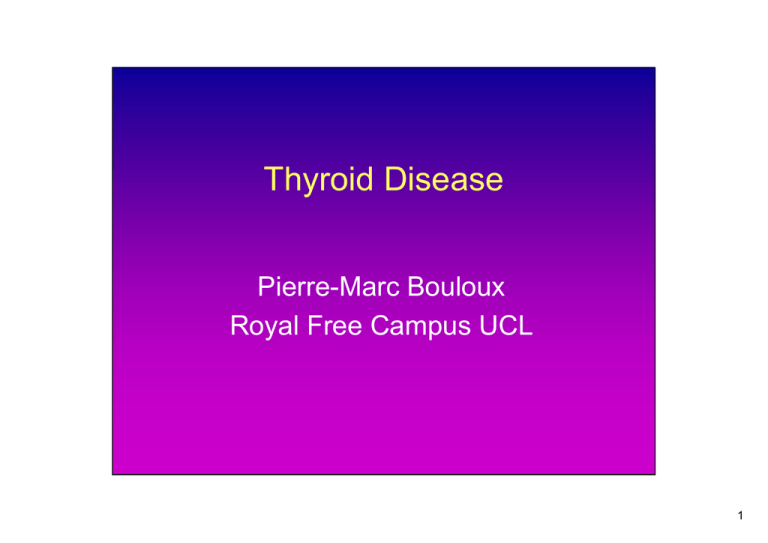
Thyroid Disease Pierre-Marc Bouloux Royal Free Campus UCL 1 Hypothalamic-PituitaryThyroid Axis 2 Thyroid Physiology • Transport of iodide into thyroid cell • Iodide is then oxidised to effect the iodination of thyroglobulin resulting in formation of mono- and di-iodotyrosines • Iodotyrosines oxidised to form T4 (100%) and T3 (20%) - released into circulation • 80% of T3 is produced by peripheral monodeiodination of T4 in liver – some circulating T4 is converted into inactive reverse T3 – alterations of activities of the deiodinases will change concs of T4, T3 and reverse T3 3 Case Study 1 • 68 year-old woman with 10-year history of anxiety - now has nocturnal palpitations and lethargy • In sinus rhythm 100/min, no goitre • TFTs performed to exclude thyrotoxicosis: • TSH 3.6mU/l (0.5-5), FT4 40pmol/l (9-25) • What should be done? 4 Normal/Raised TSH, Raised FT4 or FT3 • • • • • • • Interfering antibodies to thyroid hormones Intermittent T4 therapy or T4 overdose Resistance to thyroid hormone TSH secreting pituitary tumour Amiodarone Acute psychiatric illness Familial dysalbuminaemic hyperthyroxinaemia 5 Anti-Thyroid Antibody Interference • Suspect if FT4 and FT3 assays are widely discordant with each other • Usually evidence of thyroid autoimmunity • Anti-T4 and anti-T3 antibodies more common in free than total thyroid hormone assays • Determine free thyroid hormone levels by equilibrium analysis where confounding antibody is excluded by dialysis membrane • Thyroid function can be monitored by TSH once interference confirmed 6 Thyroid Hormone Resistance • Syndrome of reduced responsiveness of target tissues to thyroid hormone • Thyroid hormone receptor mutations • Usually family history of thyroid hormone resistance or goitre (dominant) • Absence of usual symptoms/consequences • Absence of pituitary tumour on MRI • Normal SHBG • Normal/exaggerated response to TRH • Normal alpha-subunit/TSH ratio • Thyroablative treatment not indicated 7 Effects of Drugs on the Thyroid 8 Circumstances Associated with Altered T4 Requirements • ↓requirements - ↑ age, androgen Rx • ↑requirements – HRT, pregnancy, malabsorption • Drugs which ↓absorption - high-fibre, sucralfate, aluminium hydroxide, ferrous sulphate, cholestyramine • Drugs which ↑clearance - rifampicin, carbamazepine, phenytoin 9 Case Study 2 • 74 year-old man with a diagnosis of CCF, presumed secondary to IHD, complains of having “no energy at all” • TFTs: TSH 7mU/l (0.5-5), FT4 12pmol/l (9-25) • What should be done? 10 TFTs in Hospital In-Patients • Isolated alterations in TSH concs (either low 0-1-0.3 or high 5-20mU/L) occur in 15% due to response to non-thyroidal illness or drugs • 2-3% of hospitalised patients have suppressed TSH concs (<0.1mU/L) or elevated (>20mU/l) 11 Outcome - Low Serum TSH 12 Outcome – High Serum TSH 13 Prevalence of Overt Thyroid Disease • Hyperthyroidism Point prevalence rates 0.3-1% Accurate diagnosis if clinical indications exist, accurate drug history, if abnormal TSH confirmed and reciprocal change in FT4 • Hypothyroidism Point prevalence 2% even in elderly women Subjects tend to be older and have more severe illnesses, but limiting to women >50 would have missed 40% of those with significant hypo 14 Case Study 2 continued • TSH 7mU/l (0.5-5), FT4 12pmol/l (9-25) • Diagnosis Probably response to non-thyroidal illness ?evidence of mild thyroid failure secondary to autoimmune thyroid disease • Plan Do nothing and repeat TFTs in recovery in 2 months (plus thyroid antibodies) 15 Case Study 3 “Will thyroxine help me doctor?” • • • • 55 year-old woman (Teacher) C/o lethargy for many years to GP FT4 14pmol/L, TSH 5.6mU/L T-C 6.4mmol/L, LDL-C 4.2mmol/L, HDL 1.6mmol/L, Trig 1.5mmol/L • Should this patient receive thyroxine? 16 The Percentage of Subjects with Elevated TSH by Age and Gender in Colorado Study 17 Mild Thyroid Failure • Raised serum TSH >4.5mU/L but normal FT4 • Absence of hypothalamic/pituitary disease, non-thyroidal illness or drugs • Cause: Chronic autoimmune thyroiditis in iodine-replete communities • 8% women (10% >55 yrs) and 3% men • Most diagnosed in primary care after investigation of symptoms or screening • 74-87% will have TSH 5-10mU/L 18 Hypothyroidism Probability in 60 year-old Woman at Whickham 20-Year Follow-Up TSH (mU/L) Thy Ab Probability 2 - 3% 2 + 17% 5 - 17% 5 + 55% 10 - 44% 10 + 83% 19 Mild Thyroid Failure Symptoms • • • • 5 double-blind randomised trials Follow-up periods 6 months to 1 year Sample sizes 20-63 in age 45-73 years 3 studies showed improvement in symptoms although 1 only if TSH >12 • 2 studies no benefit in symptom scores • ?selection bias as patients with poor quality of life more likely to have TFTs 20 Dyslipidaemia • Most studies show association with raised LDL-C, low HDL-C and raised lipoprotein(a) • Total-C increased by 0.5mmol/L and intervention studies with T4 lower by 0.2-0.4mmol/L • In the only RCT, improvement in lipid profile only seen if TSH >10mU/L 21 Subclinical Hypothyroidism Quality of Evidence (JAMA 2004) Serum TSH Hypothyroid CVD Lipids ECHO Symptoms Association? 4.5-10 >10 Good Good Insuf Insuf Insuf Fair ? Insuf None Insuf Treatment? 4.5-10 >10 None None Insuf Insuf Insuf Insuf Insuf Insuf 22 Compliance • Long-term consequences of inadequate treatment or over-treatment with T4 • In UK community studies 50% of treated hypothyroid patients have TSH levels above/below reference range • Colorado survey – 1525 on T4 – subclin hypo in 18% and subclin hyper in 21% • ?care with T4 in elderly with IHD 23 Subclinical Hypothyroidism Guidelines • Raised TSH and low FT4 is overt hypothyroidism and requires T4 • If FT4 normal and TSH >10mU/l, then T4 is usually justified • If TSH 5-10mU/L and thy ab+, then annual check - T4 once TSH >10mU/L • If TSH 5-10mU/L and thy ab-, then ensure check every 3-5 years only • No evidence for T4 if TSH 2.5-5mU/L 24 Case Study 4 “I don’t feel right on thyroxine” • 37 year old woman • 12 months post I131 for Graves’ disease and hypothyroid within 4 months • On thyroxine 150mcg daily • Still c/o lethargy • FT4 23pmol/L, TSH 0.02mU/L • Patient asks for a prescription for T3 • What would you do? 25 Treatment of Hypothyroidism • Hypothyroid patients who continue to have symptoms despite T4 replacement • Rat studies suggest that only the T4 and T3 ensures euthyroidism in all tissues except in brain where T4 alone • Initial study showing benefit of T4 and T3 suggested benefit in thy ca patients • 3 subsequent randomised crossover or parallel studies in 2003 failed to show benefit • Significant improvement in symptom score in “control” group emphasises placebo effect 26 Case Study 5 “ I want you to prescribe armour” • 55 year-old woman (Teacher) • C/o lethargy, weight gain, scalp hair loss for six months • FT4 14pmol/L, TSH 2.4mU/L • Claims that she has the clinically syndrome of hypothyroidism and doesn’t believe blood test • Seen in Harley Street – begun on Armour • Patient asks GP to continue prescription 27 What is “Armour” • Natural desiccated thyroid hormone containing T4 and T3 • Extracted from pig thyroid glands • Tablets contain approximately 38mcg of T4 and 9mcg of T3 – wide variety of strengths • Authorised by the FDA but not by UK • Can be imported if prescribed • No evidence of benefit in those with normal TSH 28 Case Study 6 • 67 year-old woman • Presented 30 years ago with myalgia and lethargy • Told hypothyroid and begun on T3 40mcg daily • Recent TFTs: FT3 10.3 (3-7), FT4 0.7 (1020) and TSH 0.02 (0.4-4mU/l) • What would you advise? 29 Treatment of Hypothyroidism • Rat studies suggest that only the T4 and T3 ensures euthyroidism in all tissues except in brain where T4 alone • Initial study showing benefit of T4 and T3 suggested benefit in thy ca patients • 3 subsequent randomised crossover or parallel studies in 2003 failed to show benefit • Significant improvement in symptom score in “control” group emphasises placebo effect • No evidence for benefit from desiccated thyroid hormone extracted from pig thyroid glands containing T4 and T3 30 Case Study 7 “Will treating my thyroid help my heart and bones?” • 77 year-old lady • Recent ward admission with AF – otherwise no symptoms • TFTs returned after discharge: FT4 17.9pmol/l, FT3 6.8pmol/l, TSH 0.1mU/l • Referral from cardiologists – should this abnormality be treated? 31 Prevalence of Subclinical Hyperthyroidism Study N Age Whickham Birmingham Colorado NHANES III 1704 1210 25862 13344 38+ 60+ 18+ 12+ Men Women 3% 6% 1.0% 0.7% 32 Subclinical Hyperthyroidism • Low serum TSH but normal FT4 • Absence of hypothalamic/pituitary disease, non-thyroidal illness or drugs • Cause: exogenous from T4 therapy or endogenous as in overt hyperthyroidism • 2% of population have subnormal and 1% undetectable serum TSH • Annual incidence of hyperthyroidism 5% 33 Subclinical Hyperthyroidism Symptoms • Small case-control, cross-sectional, and cohort studies - more signs and symptoms but selected from hospital clinics and elderly in-patients • Only large population study - no association between TSH<0.2mU/l and physical or psychological symptoms • Subgroup of Rotterdam cohort - that TSH <0.4mU/l associated with x3 dementia risk 34 Subclinical Hyperthyroidism Atrial Fibrillation 35 Prediction of All-Cause Mortality from TSH: 10-year Cohort Study 36 Prediction of CVD Mortality from TSH 10-year Cohort Study 37 Subclinical Hyperthyroidism Bone Density • Two meta-analyses report ↓BMD during prolonged subclinical hyperthyroidism - postmenopausal women only • Prospective study reported increased hip/spine fracture in women >65 with TSH<0.1mU/l but not if 0.1-0.5mU/l • Study of 1,100 patients on T4 in Scotland found no difference in fracture rates • Population case-control study in 23,183 on T4 – independent fracture risk in men only 38 Subclinical Hyperthyroidism Quality of Evidence (JAMA 2004) TSH (mU/l) Hyperthyroid Cardiac AF BMD Symptoms Association? 0.1-0.5 <0.1 Insuf Good Fair Fair Insuf Good None Fair Insuf Insuf Treatment? 0.1-0.5 >10 None None None None None None None Fair None Insuf 39 Case Study 8 • 68 year-old woman with history of MI treated with amiodarone for 12 months for resistant PAF • GP checks thyroid function at “well-woman screen” and result sent to cardiologist as due for routine review in 1 month • FT4 14pmol/l, TSH 20mU/L • How would you manage this patient? 40 Amiodarone and the Thyroid • Amiodarone contains two iodine atoms • 200mg Amiodarone contains 74.4mg iodine • Metabolism in liver releases approx 3mg of inorganic iodine/100mg into the systemic circulation – diet average is 0.5mg/day • Large iodine doses acutely (transiently in 2 weeks) inhibit binding of iodine to TG leading to reduced T4/T3 synthesis (Wolff-Chaikoff) • Inhibits monodeiodination of T4 thus decreasing T3 production • Blocks T3-receptor binding to nuclear receptors 41 Effects of Amiodarone on Thyroid Function • Changes primarily due to impaired deiodination of T4 to T3 • TSH ↑initially then↓to low/normal 2-3 months – occasional intervals of low TSH • FT4 ↑20-40% in 1st month, then gradually fall to baseline but remains high/normal • FT3 ↓30%, then remain low/normal • rT3 ↑ 20% then remain high 42 Amiodarone-Induced Hypothyroidism 1 • Incidence of 13% in areas of high iodine intake to 6% where low iodine intake • Risk is dose independent but enhanced in elderly and women – ATD • Inability of thyroid to escape from the acute inhibitory effects of iodine on hormone synthesis and release • May reflect underlying ATD –usually occurs early within 3-12 months 43 Amiodarone-Induced Hypothyroidism 2 • Clinical features not affected although most patients have few symptoms – lethargy • Biochemical diagnosis – TSH>20mU/l and FT4<12pmol/l • Stop amiodarone? Rarely acceptable! • Continue amiodarone and replace with T4 until TSH within reference range • If TSH 5-20mU/l, FT4 N – check thy ab • If thy ab neg – watch for 3-6 months 44 Case Study 9 • 83 year old woman with recurrent VT begun on Amiodarone in November • Presented with wt loss 5Kg and dysphagia • Past history of nodular goitre Rx thyroidectomy • FT4 40pmol/l, FT3 6pmol/l (3-7pmol/l), TSH <0.01mU/l • How would you manage this patient? 45 Effects of Amiodarone on Thyroid Function • Changes primarily due to impaired deiodination of T4 to T3 • TSH ↑initially then↓to low/normal 2-3 months – occasional intervals of low TSH • FT4 ↑20-40% in 1st month, then gradually fall to baseline but remains high/normal • FT3 ↓30%, then remain low/normal • rT3 ↑ 20% then remain high 46 Amiodarone-Induced Hyperthyroidism 1 • Less common in iodine-replete areas such as UK – 2% (cf 13% hypothyroidism) • Occurs more frequently in men and ↓iodine • No relation with daily or cumulative dose • Onset often acute but may occur months after discontinuation. Remissions common. • Clinical features often obscured but new/recurrent atrial arrhythmias, HF, wt loss • ↑FT3 and undetectable TSH (↑SHBG) 47 Amiodarone-Induced Hyperthyroidism 2 Type 1 Type 2 Prev thyroid Yes No abnormality Pathogenesis ↑synthesis due ↑release of to I excess hormone Goitre MNG/diffuse No occ tender Isotope uptake Normal/raised Low/absent Colour Doppler Increased flow Absent 48 When Amiodarone can be stopped • Non-life threatening arrhythmia ?alternative • Caution that amiodarone may paradoxically be protecting from effects of thyrotoxicosis • Type 1 – rarely respond to amiodarone withdrawal alone – most still hyperthyroid 6-9 months later – use of Carbimazole in high doses often required and Potassium Perchlorate to block iodide uptake ?I131 or thyroidectomy • Type 2 – withdrawal may suffice – majority euthyroid in 3-5 months – steroids accelerate recovery – no use for carbimazole/I131 49 When Amiodarone cannot be stopped • Cessation of amiodarone may exacerbate the thyrotoxic/cardiac status • Alternative strategies such as ablation and implantable defibrillators inappropriate • Further de novo assessment may be difficult to interpret if thyrotoxic/on amiodarone • Consequences of new antiarrhythmic in thyrotoxic with tissues saturated with amiodarone cannot be predicted • May be safer to persist with amiodarone and treat the thyrotoxicosis - ↓good outcome 50 Monitoring Thyroid Function in Patients on Amiodarone • Baseline TFTs including FT4, TSH, thy ab • If pre-treatment TSH ↑/N and thy ab+ then risk of hypothyroidism and need follow-up • If TSH ↓/N, probable risk of thyrotoxicosis • Check every 6 months routinely and low threshold for testing if any suspicion • Equivocal results require repeat in 6 weeks • Continue checking after withdrawing Rx 51 Case Study 10 • Philip presented in April 1998 aged 20 • Episode of chest tightness whilst training as professional rugby player • FT4 77, TSH <0.03 • Visible large smooth goitre with bruit • No eye signs • How would you manage this patient? 52 Case Study 10 • Recommendation to commence CBZ therapy (60mg daily) with plan to consider thyroidectomy in 3 months • At 3 months after extensive consultations (inc father who was former surgeon), opted for continuation of CBZ until rugby career over (Saracens/Eng U21s) • Remained on high-dose CBZ • Reported proximal myopathy and gynaecomastia and psych disturbance • Signed off for rugby insurance Dec 1999 53 Case Study 10 • Lost to follow-up until April 2005 • Returned from Bristol after I131 2002 • Post I131 developed active thyroid eye disease – upset re info given • Off and on low dose CBZ post I131 • Still toxic and recommenced CBZ 10mg daily • Now offer thyroidectomy • Begun on T4 therapy immediately post-op 54 Hyperthyroidism • Affects approximately 2% women and 0.2% men • 3 principle treatments – anti-thyroid drugs, radioiodine and surgery • All effective • Opinions differ about the indications because no single treatment regularly results in permanent euthyroidism 55 Investigation • Confirm diagnosis biochemically • Permanent or transient • Aetiology – Graves’, Nodular disease, Thyroiditis (viral, autoimmune), Drugs • Select appropriate management 56 Initial Management • Beta-blockers? • Carbimazole therapy – titrate vrs blockreplace • Role of radioiodine therapy • Role of surgery 57 Radioiodine • Increasingly used as first line therapy for Graves hyperthyroidism • Treatment of choice for recurrent hyperthyroidism after ATD Rx • Dose • Outcome • Safety • Eye Disease? 58 Surgery in Management of Overactive Thyroid • • • • • • • Patient choice/Large goitres/Cosmetic Total thyroidectomy is usual Complication rate low Euthyroid prior to surgery Option for those with active eye disease All aetiologies but normally Graves’ Good surgeon 59 Cost-Effectiveness of Treatment • 135 patients with thyrotoxicosis referred in 12 months (13 transient) • 62% Graves, 7% nodular, 5% thyroiditis, 27% unknown • 74 received ATDs, 43 I131, 5 had Tx • Cure defined as euthyroid 12 months after ATD or euthyroid or on T4 at 24 months post I131 or Tx • Costs included OP attendances, lab tests and initial an subsequent treatments 60 Outcomes Rx N Cured ATD 74 54 Total Costs Failed Lost Costs /Cure Rx F-U £ £ 2186 2995 12 15 Tx 5 5 6651 6551 0 0 131I 43 41 1581 1618 1 1 61 Hyperthyroidism - Summary • Affects approximately 2% women and 0.2% men • 3 principle treatments – anti-thyroid drugs, radioiodine and surgery • Differential diagnosis of elevated thyroid hormone levels but normal TSH • Management options in amiodaroneinduced thyrotoxoicosis 62 Thyroid Nodules Case Scenarios 1. 64-year-old woman with large multinodular goitre – presented with neck discomfort. 2. 33-year-old woman presented with neck swelling – clinically has 3cm on palpation. 3. 77-year-old man investigated for TIAs with carotid dopplers – told by radiologist that 1.2cm nodule seen which requires follow-up. 63 The Prevalence of Goitre, Raised Serum TSH and Thyroid Antibodies in Men and Women at first Whickham Survey 64 Nodular Goitre Prevalence by Palpation Study Year N Framingham 1968 5127 Whickham 1977 2779 Age Prevalence 30-59 M 1.5%, W 6.4% 18+ M 0.8%, W 5.3% Denmark 1983 296 13-90 6.1% Finland 1991 253 19-50 5.1% Germany 1991 569 60+ 17.6% Jutland 1998 423 68 M 3.2%, W 12.2% Iceland 1998 100 66-70 2% 65 Nodular Goitre Incidence in Framingham Cohort • 4909 subjects aged 30-60 years without nodules followed for 2-15 years • Incidence 1.1/1000 women 0.6/1000 men • 74% of nodules unchanged at 15 years • Prevalence much higher than incidence 66 Nodular Goitre Prevalence by Ultrasound Study Year N Age % Belgium 1985 300 0-90 19 Finland 1991 253 19-50 27 Germany 1991 569 60+ 18 France 1994 1000 18+ 35 Italy 1999 992 15+ 17 67 Nodular Goitre Ultrasound Studies • High resolution U/S can detect nodules as small as 1mm • Prevalence of nodules higher in women than men and increase with age • Comparison with palpation findings • Significance of high prevalence (especially in older women) is unclear 68 Nodular Goitre Autopsy Studies • Prevalence ranges from 8% to 65% in nonendemic and endemic regions • Mayo Clinic autopsy series – 49.5% of 821 consecutive autopsies had macroscopic lesions seen in 2cm slices • Boston Hospital Series – 8.2% had nodules >1cm • High prevalence of occult thyroid cancer detected at autopsy 3-28% (median 6%) 69 Thyroid Cancer Annual Incidence and Mortality Rates SEER cancer statistic review 1973 - 1992 70 Nodular Goitres • Clinically apparent nodules in 4-7% of the population • More common in women and elderly • When sought by U/S scan, unsuspected nodules found in 44% women/20% men • Approx 90% of solitary nodules benign • Thyroid cancer rare 2-4/100,000 per yr • The challenge is to identify those few that are caused by thyroid cancer 71 Nodular Goitres Factors Favoring Benign Disease • • • • • • Family history of ATD Family history of benign thyroid nodule Presence of hypo/hyperthyroidism Associated pain or tenderness Soft, smooth, mobile nodule Multinodular goitre without a dominant nodule 72 Nodular Goitres Factors Increasing Suspicion • • • • • • • Age <20 or >70 years Gender (Men x2 women) Associated dysphagia/hoarseness History of external neck DXT Family history of thyroid cancer Cervical lymphadenopathy Firm, hard, irregular, fixed nodule 73 Investigations • Laboratory – serum TSH +/- TPO, Calcitonin if MTC or MEN 2 suspected • Isotope scan – rarely needed unless thyroiditis suspected or TSH <0.1mU/L • U/S – rarely required initially – can be used to guide FNA or determine dominant nodule within MNG – main other role is follow-up of thy ca 74 Fine Needle Aspiration Cytology • Most effective method for distinguishing benign/malignant disease • In large series: 57% benign, 24% indeterminant, 16% non-diagnostic and 3% malignant • Sensitivity 68-93% (median 83%) • Specificity 72-100% (median 92%) • Surgical yield for thyroid cancer increased from 15% to 45% over past 2 decades 75 Thyroid Nodules (Single >1cm or Dominant) • Malignant – surgery (thyroidectomy) • Benign – follow clinically (?repeat FNA in 3 months and if confirmed, discharge) • Suspicious (ie follicular lesion) – recommend lobectomy and ?proceed • Non-diagnostic – repeat in 3 months with U/S guidance 76 Fine Needle Aspiration Cytology - Problems • Skill of person performing biopsy • Experience of cytopathologist – importance of Multidisciplinary meetings • Should it be U/S guided? • Dominant nodules within MNG – same prevalence of malignancy as single nodules • Thyroid incidentalomas? (1.0-1.5cm) 77 Thyroid Incidentalomas Questions • Is there a size criterion below which FNAC not required? • Are there diagnostically reliable U/S criteria to determine selection for FNA? (solidity, hypoechogenecity, punctate calcification) • If cytology non-diagnostic/inconclusive, is it useful/necessary to repeat FNAC? • What does cytological diagnosis of malignancy mean biologically? 78 Management of Euthyroid Multinodular Goitre • If symptomatic, investigate with flowvolume loop/CT scan ?tracheal compression • Consider thyroidectomy or I131 • No role for thyroxine therapy • Long-term risk of hyperthyroidism(?) – recommend follow-up TFTs 79 Clinical Scenarios - Answers 1. 64-year-old woman with large multinodular goitre – presented with neck discomfort. 2. 71-year-old man presented with neck swelling – clinically has 3cm on palpation. 3. 77-year-old man investigated for TIAs with carotid dopplers – told by radiologist that 1.2cm nodule seen which requires follow-up. 80 Conclusions • Interpretation of thyroid function tests • Subclinical thyroid disease • Management of amiodarone induced thyroid dysfunction • Controversy in hypothyroidism and thyroxine replacement • Pitfalls in hyperthyroidism • Management of thyroid nodules 81

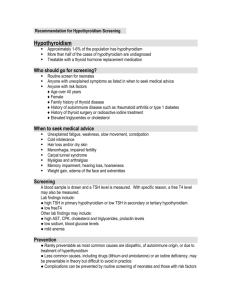
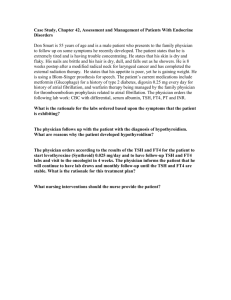
![Anti-TSH antibody [M1A10] ab131725 Product datasheet Overview Product name](http://s2.studylib.net/store/data/011961926_1-244ef1e2c62e8645787745e7b77af046-300x300.png)
